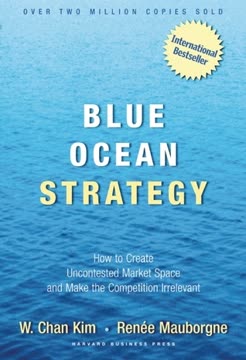Key Takeaways
1. Develop a Simple, Clear Strategy to Align Your Organization
"Simplifying complexity is a leader's superpower."
Clarity is crucial. Leaders must distill complex strategies into simple, memorable plans that every employee can understand and act upon. This "simple plan" should answer two key questions for all staff: What should I be working on? Why is it important?
Communicate relentlessly. Once developed, leaders must repeat the strategy consistently across all channels. Use clear language, avoid jargon, and create catchy phrases or metaphors to make the message stick. For example, Disney's Bob Iger focused on three priorities: generating the best creative content, fostering innovation and technology, and expanding globally.
Measure and adjust. Develop clear metrics to track progress towards strategic goals. Be willing to refine the strategy based on results and changing conditions. Regular check-ins with employees can help ensure the strategy remains understood and relevant throughout the organization.
2. Build a Culture That Matters Through Consistent Actions
"Culture is almost like a religion. People buy into it and they believe in it. And you can tolerate a little bit of heresy, but not a lot."
Define core values. Work with employees to articulate the organization's fundamental beliefs and expected behaviors. These should be specific enough to guide decision-making but broad enough to apply across the company.
Live the values. Leaders must consistently model the desired behaviors, as employees watch their actions closely. Reinforce cultural values through:
- Hiring and promotion decisions
- Recognition and rewards
- How conflicts are resolved
- Stories and traditions celebrated within the company
Measure cultural health. Regularly survey employees to gauge how well the stated values align with day-to-day experiences. Act quickly on feedback to show employees their input matters. Be willing to part ways with "culture felons" who consistently undermine core values, regardless of their performance.
3. Create High-Performing Teams by Fostering True Teamwork
"The top three keys to success are the team you build, the team you build, and the team you build."
Define team purpose. Clearly articulate why the team exists and what success looks like collectively, beyond individual goals. Focus on 3-4 key priorities that require the combined efforts of the entire group.
Select members carefully. Assess not just individual talent, but how well potential members will work together. Be willing to make tough personnel decisions to ensure the right mix of skills and personalities.
Establish team norms. Work together to create explicit agreements on how the team will operate, communicate, and hold each other accountable. Foster psychological safety so members feel comfortable speaking up and taking risks.
Lead by example. As the team leader:
- Create an environment of trust and open communication
- Ensure all voices are heard in discussions
- Provide clear decision-making processes
- Coach individuals to improve and grow
- Actively look for ways to develop future leaders
4. Lead Transformation by Embracing Change and Disruption
"It's not just about being a team for team's sake. It was grounded in the idea that we can't get done what we want to get done unless we operate effectively as a team."
Build the case for change. Use data and storytelling to create a shared understanding of why the status quo is no longer viable. Involve employees in identifying challenges and opportunities to increase buy-in.
Clarify the vision. Articulate a compelling picture of the future state and how it connects to the organization's core purpose. Be clear about what will and won't change to provide stability amidst uncertainty.
Empower broad participation. Engage employees at all levels to develop transformation strategies, fostering a sense of ownership. Create cross-functional teams to tackle key initiatives and break down silos.
Communicate constantly. Provide regular updates on progress, challenges, and wins. Acknowledge uncertainty while expressing confidence in the team's ability to adapt. Use multiple channels to reach all employees and reinforce key messages.
5. Listen Actively to Detect Both Opportunities and Threats
"Listening is actually being alert to the whole ecosystem in which you operate."
Create listening systems. Develop formal and informal channels to gather unfiltered information from all levels of the organization. This may include:
- Regular town halls with anonymous Q&A
- Skip-level meetings
- Employee surveys
- Walking the halls and visiting frontline operations
Seek diverse perspectives. Cultivate relationships with a broad network of internal and external contacts to gain different viewpoints. Be open to contrarian opinions that challenge your assumptions.
Listen for understanding. Practice being fully present in conversations, focusing on comprehension rather than formulating responses. Pay attention to non-verbal cues and what's not being said.
Act on insights. Demonstrate the value of speaking up by taking action on the feedback received. Close the loop by communicating how input influenced decisions or led to changes.
6. Navigate Crises with Calm Leadership and Swift Action
"How do you know what I need to know?"
Stay calm and focused. In a crisis, your demeanor sets the tone for the organization. Acknowledge the gravity of the situation while projecting confidence in the team's ability to respond effectively.
Gather facts quickly. Assemble a core team to rapidly assess the situation and separate facts from assumptions. Develop a working hypothesis about what happened and why, updating as new information emerges.
Communicate transparently. Share what you know, what you don't know, and what you're doing to find out more. Be honest about the challenges while outlining concrete steps being taken. Update stakeholders frequently, even if there's little new information.
Take decisive action. Move swiftly to address immediate concerns and mitigate further damage. Demonstrate accountability by acknowledging mistakes and outlining plans to prevent recurrence.
Learn and adapt. After the immediate crisis passes, conduct a thorough review to identify lessons learned and necessary systemic changes. Use the experience to strengthen crisis preparedness for the future.
7. Master the Inner Game of Leadership to Handle Paradoxes
"Real creativity comes from the ability to tolerate the confusion and to be able, in the right moment, to land the decision and then move forward with that decision in a structured way."
Embrace paradoxes. Effective leadership often requires balancing seemingly contradictory approaches:
- Confident yet humble
- Urgent yet patient
- Compassionate yet demanding
- Optimistic yet realistic
Develop self-awareness. Regularly reflect on your leadership style, strengths, and areas for growth. Seek feedback from trusted advisors who will give you honest input.
Manage your energy. Leadership is demanding, so prioritize self-care to maintain physical and emotional resilience. This includes:
- Regular exercise
- Adequate sleep
- Time for reflection and recharging
- Nurturing personal relationships outside of work
Stay grounded. Combat ego inflation by:
- Cultivating relationships with people who will give you candid feedback
- Staying connected to frontline operations and customers
- Remembering that your role is temporary and in service of the organization's mission
Continually learn and grow. Seek out new experiences and perspectives to broaden your thinking. View setbacks as opportunities for growth and development.
Last updated:
FAQ
What's "The CEO Test: Master the Challenges That Make or Break All Leaders" about?
- Focus on Leadership Challenges: The book explores the critical challenges that leaders face, which can determine their success or failure. It provides insights into mastering these challenges to become an effective leader.
- Seven Key Tests: It outlines seven tests that leaders must pass, including developing a strategy, building a culture, forming effective teams, leading transformation, listening, handling crises, and mastering the inner game of leadership.
- Insights from CEOs: The authors, Adam Bryant and Kevin Sharer, draw on interviews with over 600 CEOs and their own experiences to provide practical advice and real-world examples.
Why should I read "The CEO Test"?
- Practical Guidance: The book offers actionable advice for leaders at all levels, not just CEOs, making it relevant for anyone aspiring to improve their leadership skills.
- Real-World Examples: It includes stories and lessons from successful CEOs, providing a rich source of inspiration and learning.
- Comprehensive Framework: The seven tests provide a structured approach to understanding and mastering the complexities of leadership.
What are the key takeaways of "The CEO Test"?
- Simplifying Complexity: Leaders must develop the ability to simplify complex issues and communicate them clearly to their teams.
- Building Culture: Creating a strong, values-driven culture is essential for organizational success and requires leaders to model and reinforce desired behaviors.
- Handling Crises: Effective crisis management involves understanding the facts, acting quickly, communicating transparently, and addressing root causes.
What are the best quotes from "The CEO Test" and what do they mean?
- "Simplifying complexity is a leader’s superpower." This emphasizes the importance of distilling complex issues into clear, actionable strategies.
- "Culture is almost like a religion." It highlights the deep commitment and belief that a strong organizational culture can inspire among employees.
- "The leader’s job is to simplify complexity, and be right." This underscores the dual responsibility of leaders to clarify issues and make correct decisions.
How does "The CEO Test" define effective leadership?
- Balancing Paradoxes: Effective leadership involves navigating paradoxes, such as being confident yet humble, and urgent yet patient.
- Listening Skills: Leaders must actively listen to understand the true dynamics within their organization and respond appropriately.
- Team Building: Building cohesive teams that work well together is crucial for executing strategies and achieving goals.
What is the "big idea" question in strategy development according to "The CEO Test"?
- Core Message: The "big idea" question challenges leaders to crystallize the essence of their strategy in a simple, memorable way.
- Strategic Clarity: It helps ensure that everyone in the organization understands the strategic goals and their role in achieving them.
- Decision-Making Tool: This approach aids in prioritizing actions and aligning resources with the most critical objectives.
How does "The CEO Test" suggest leaders handle crises?
- Understand the Facts: Leaders must quickly gather and comprehend the facts to make informed decisions.
- Act Fast: Immediate actions are necessary to mitigate the impact of the crisis and reassure stakeholders.
- Communicate Widely: Transparent communication is crucial to maintain trust and provide updates as the situation evolves.
What role does culture play in leadership according to "The CEO Test"?
- Foundation of Success: A strong culture aligns employees with the organization's values and goals, driving performance and engagement.
- Leader's Responsibility: Leaders must own and model the culture, ensuring that it is reinforced through actions and decisions.
- Continuous Process: Building and maintaining a culture is an ongoing effort that requires regular assessment and adaptation.
How can leaders improve their listening skills as per "The CEO Test"?
- Active Listening: Leaders should focus on understanding rather than responding, creating an environment where employees feel heard.
- Feedback Systems: Implementing structured feedback mechanisms helps leaders stay attuned to the organization's pulse.
- Regular Engagement: Leaders should engage with employees at all levels to gather diverse perspectives and insights.
What is the significance of transformation in "The CEO Test"?
- Ongoing Challenge: Transformation is a continuous process that requires leaders to balance current operations with future disruptions.
- Engaging the Organization: Successful transformation involves engaging employees in developing and owning the change strategy.
- Clear Communication: Leaders must communicate the need for change and the vision for the future to align and motivate the organization.
How does "The CEO Test" address the inner game of leadership?
- Self-Awareness: Leaders must understand their strengths and weaknesses to navigate the complexities of leadership effectively.
- Balancing Demands: The inner game involves managing conflicting demands and maintaining personal well-being.
- Constructive Selfishness: Leaders should prioritize self-care to sustain their energy and effectiveness in leading others.
What are the common mistakes leaders make during crises according to "The CEO Test"?
- Denial: Leaders often downplay the severity of a crisis, delaying necessary actions and eroding trust.
- Overpromising: Making statements beyond what is known can damage credibility and complicate crisis management.
- Lack of Transparency: Failing to communicate openly with stakeholders can lead to misinformation and increased anxiety.
Review Summary
The CEO Test receives positive reviews for its insightful leadership advice, practical examples, and clear structure. Readers appreciate the book's concise yet comprehensive approach to addressing key challenges faced by leaders at all levels. Many find the seven tests and paradoxes particularly valuable. While some critics note that the advice can be generic, most reviewers recommend it as an excellent resource for current and aspiring leaders. The book's real-life examples and focus on both the external and internal aspects of leadership are frequently praised.
Similar Books










Download PDF
Download EPUB
.epub digital book format is ideal for reading ebooks on phones, tablets, and e-readers.




